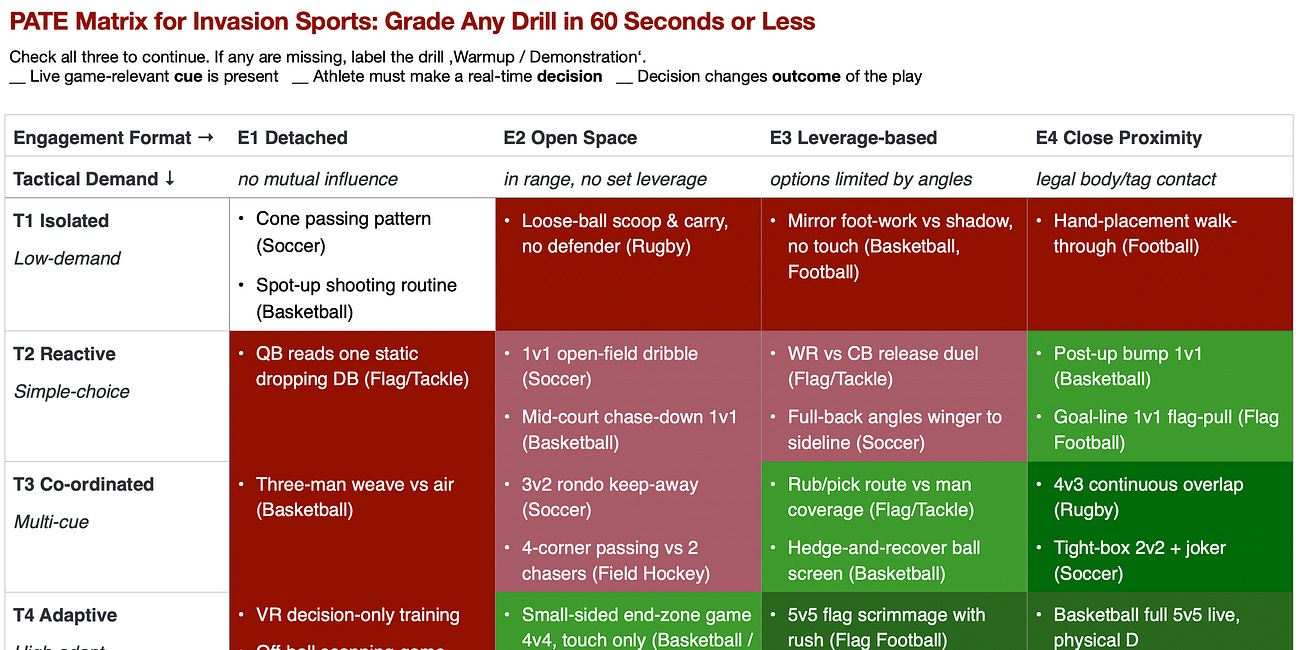You’re midway through practice. Sweat’s beading, cones are flying, whistles cut the air. Players look busy—so why does the voice in your head whisper, “This isn’t landing.”
Most coaches plough ahead—clock screaming, session plan untouchable. Result? The block ticks away, and the first chance to rescue the drill won’t show up until next practice—assuming we’re ready to tweak it.
Today we fix that.
For readers who followed the PATE Matrix series, you already have the map. This post adds the dashboard: a quick, mid‑drill reflection loop that keeps every rep tethered to the game. Think of it as tapping the brakes just long enough to steer before you skid.
3 Key Takeaways:
Micro‑loops save reps: A 30‑second PATE Ping mid‑drill rescues learning before it drifts.
PICOD spots the leak: Pressure, Information, Coordination, Opponent, Decision reveal the drill’s weakest hinge in one glance.
One tweak, instant upgrade: Shift a single constraint—space, numbers, or rule—and athletes feel the difference immediately.
2 Thought‑Provoking Questions:
If your drill drifts off‑target today, when will you notice—and how many blank reps will it cost?
What single constraint tweak could flip your flattest rep into a live decision right now?
1 The Hidden Cost of a Wasted Rep
A fifteen‑minute block can feel productive—until you realise players made zero real decisions. No pressure, no live cues, no opponent adaptation. They leave practice fitter and no closer to solving tomorrow’s match.
Worse, the lie is seductive. Smooth choreography looks great in a clip, feels orderly on the field, and flatters our sense of control. But skill only sticks when athletes Perceive → Decide → Act against friction. If that loop is missing, you’re rehearsing a dance, not a game.
Autopilot Is the Enemy
Even elite coaches drift. You demo, you cue, you let it run… five minutes later you’re setting up the next thing while twenty athletes compile empty reps. That’s not laziness; it’s human bandwidth. The fix isn’t more willpower—it’s a system that pings you before drift becomes drain.
2 Enter the Mid‑Drill PATE Ping
You already know the PATE grid. In Part 2 we used it to grade a drill post‑hoc. Now we weaponise it in real time.
Method: set a timer every 5–10 minutes (or after each group cycles through). When it buzzes, you—or a designated athlete—ask two things:
Which PATE cell are we in? (Quick glance: are we still where we meant to be?)
What’s weakest in PICOD? (Scan the five tactical sub‑points; pick the softest.)
P – Pressure, I – Information cues, C – Coordination, O – Opponent behaviour, D – Decision load
How the Pieces Fit
Use one or stack all three—the point is you don’t wait until tomorrow to notice the hole.
Case Study: The Drill Looked Fine—Until PICOD Said Otherwise
The other day I rolled out our go‑to 2‑v‑1 flag‑pulling drill—so familiar the U13s could set it up without me. On the chart it sat at E4 × T3.
Yet after two quick rotations I saw plenty of movement but almost zero decisions. PICOD confirmed it: D for Decision‑making was flat‑lined; the kids could run the pattern in their sleep.
I slipped in one tweak—each ball‑carrier now had to pick between two evasions. The drill came alive: sharper cues, louder intent, real laughs, and a decision baked into every rep. The drill still sat at E4 × T3, but now the D score moved from 2 to 3.
I tried the same wrinkle with the U11s later; they had a blast whispering to me which move they’d try next. :-)
3 Your Reflection Toolkit
I also thought about this, but have not tried it yet:
Gold move: hand the stopwatch to a rotated “practice captain.” Peer‑led pings would probably hit different.
4 Zoom Out: Read Everything
Once the lens sharpens, you can’t un‑see fluff. Scroll your feed tonight: that perfectly choreographed cone gauntlet—where’s the live cue? The defender who never changes angle? Grade it. Would it survive a PATE ping unchanged? Probably not. Great aesthetics ≠ great affordances.
Same for your go‑to warm‑up. If it never leaves E1 × T1, label it technique and move on; just don’t fool yourself it’s game prep.
Coaching or choreographing—that choice is made every rep.
5 Call to Action: Set Your First PATE Ping
Tonight, pick tomorrow’s favourite drill. Schedule a 7‑minute alarm. Print or scribble PICOD on a Post‑it. When the alarm hits:
Freeze play.
Ask the group: “Where are we on PATE?”
Circle the limp PICOD letter.
Tweak one constraint—space, numbers, rule, time, whatever.
Roll immediately.
Run. Pause. Tweak. Repeat. Small shifts now beat big regrets later.
When you try it, hit reply or comment. What tweaked? What surprised you? Let’s crowd‑source the best micro‑check hacks.
(And tell me—should we start a monthly Drill Roast where we grade the most haunted Instagram cone cemeteries? I’m game if you are.)
See you next week—same grid, sharper eyes.
Quick‑Reference PATE Ping Table
Clip this. Add your Quick fixes. Laminate it. Tape it to your clipboard.
If you missed Parts 1‑3 of the PATE series, start here
Enjoyed this article? Subscribe to stay updated on deeper insights about navigating change in both business and sports.
📌 PS: If you found this post helpful, would you please consider restacking it and sharing it with your audience? This post is public, so feel free to share and forward it.
Rolf is a seasoned performance coach and coach developer, with a unique perspective that challenges conventional thinking. He works across both the business and sports worlds, supporting teams and individuals through change. Currently, he coaches multiple teams and provides personalized guidance to leaders in both fields.
LinkedIn
Instagram
Email: info@flag-academy.com
Email: rolf@beyondchampionships.eu
Facebook: Coaching Beyond Championships






